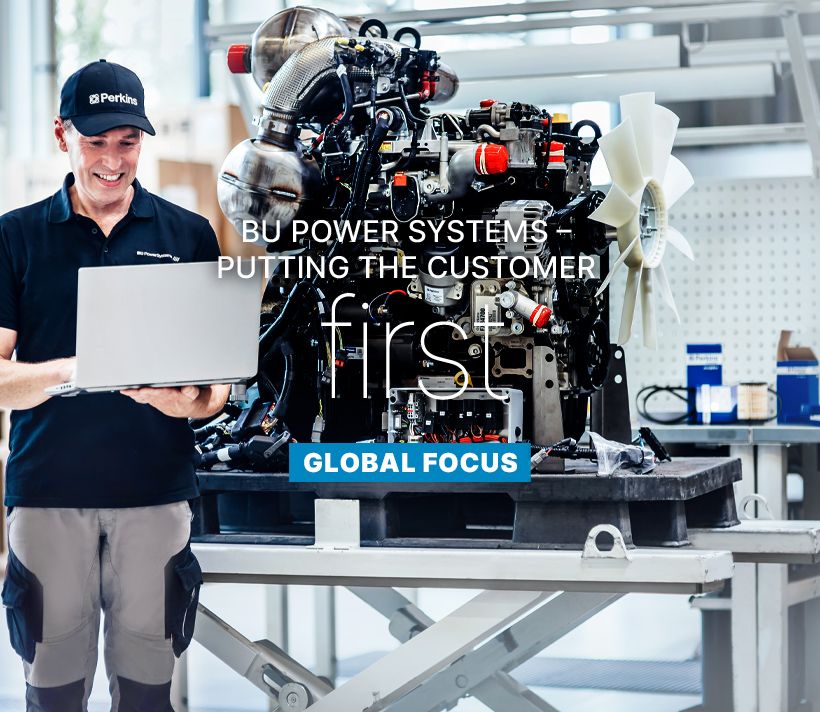An ounce of prevention is worth a pound of cure
As winter approaches in the northern hemisphere, it’s important to understand why your diesel engine is harder to start when it’s cold, and what you can do to minimise the inconvenience. This article covers the basics of successful cold-weather practices to help keep your Perkins-powered equipment working at peak efficiency.
The best answer for cold weather starting problems is to avoid them by being prepared for cold weather before it happens. As Winter weather gets more and more unpredictable, sudden shifts from moderate temperatures to freezing are becoming more common. These extremes make good maintenance for heavy equipment and diesel-powered machines in the winter even more important.
Diesel engines depend on high temperatures created by compression to ignite the injected fuel and that makes them harder to start in cold weather than a gasoline engine. In fact, starting a diesel engine at 0°F (-17°C) is five times harder than starting one at 80°F (26°C). Gelled fuel, cold cylinder walls and batteries with diminished output at low temperatures all can contribute to the difficulty which makes planning for cold weather operation critically important.
Do use winter blended fuel which is less likely to gel.
Do store full portable fuel cans in a temperature-controlled area to avoid condensation.
Do drain the water from the fuel filter daily, preferably when the machine is shut down for the day so the water does not sit in the filter overnight.
Do fill fuel tanks at the end of the working day, as a full tank doesn’t leave room for water to condense overnight.
Don’t neglect the fuel filter, it’s the most common place for fuel to gel.
Don’t forget to drain the water separator on fuel storage tanks every day.
Do change the fuel filter before winter weather sets in. That makes it less likely to freeze and avoids the need to do the job in the cold.
Do keep a spare fuel filter and/or water separator on hand. It’s often easier to replace a frozen one than it is to thaw it.
Do switch to a lighter weight engine oil during cold weather. A cold engine needs adequate lubrication especially when it’s started.
Don’t use engine oil lighter than the engine manufacturer recommends as it may not provide adequate lubrication when the engine is hot.
Do check your coolant regularly with a hydrometer. The glycol in your coolant is there for a reason, it doesn’t boil off and it lowers the freezing temperature of the mixture.
Don’t top off the coolant with plain water. Make sure to use a proper water/glycol mix every time. You do not want water to freeze in your engine or radiator.
Do pay attention to temperature gauges and avoid overcooling which can be caused by long periods of idling or excessive airflow. Overcooling can cause poor combustion leading to white smoke, increased fuel consumption, and inefficient aftertreatment system performance.
Don’t store diesel exhaust fluid (DEF) at below freezing temperatures. DEF is about 50 percent water and will freeze.
Don’t worry about DEF in the tank on the machine, the system automatically circulates engine coolant to thaw it so it’s ready for use when the machine warms up.
Do park equipment in a sheltered location whenever possible. A heated shelter is best, but simply parking where the wind can’t blow snow and ice into the engine can make a big difference when starting.
Do let a cold engine warm up for at least five minutes before putting it to work. That gives the coolant, engine oil, hydraulic oil and DEF time to come up to operating temperature so they can function efficiently.
Do consider using a block heater if one is installed or installing an aftermarket unit. A warm engine is much easier to start and avoids many of the issues related to cold weather operation.
Do inspect and, if necessary, change glow plugs and air inlet heaters before cold weather sets in. It’s another job more easily done in warmer temperatures.
Do consider using a battery warmer, either a “hot plate” type that slides under the battery or an “electric blanket” type that wraps around the battery will help the battery retain its charge.
Don’t use starting fluid unless the engine is equipped with a factory installed kit that precisely controls the amount used. Simply spraying starting fluid into the air cleaner carries a high risk of causing a fire or even an explosion.
Don’t ignore your battery. After a hot summer that encourages corrosion and fluid evaporation the added strain of cold weather starts can kill a battery. A battery can lose 35 percent of its power at 32°F (0°C) and as much as 60 percent at 0°F (-18°C).
We caught up with the team to discover how they’ve positioned themselves for year-over-year growth.
Read moreRichard Bates, Perkins product lifecycle manager, explains why genuine Perkins parts use is so important.
Read moreCalling all would-be technicians and those looking to further develop their skills and knowledge in diesel engines, maintenance and equipment operation. Perkins has just launched a free online training programme to support your development and help you build your future career in the industry.
Read morePowernews caught up with BUPS distributor principal, Franz Focks, to learn more about its work with customers.
Read more










